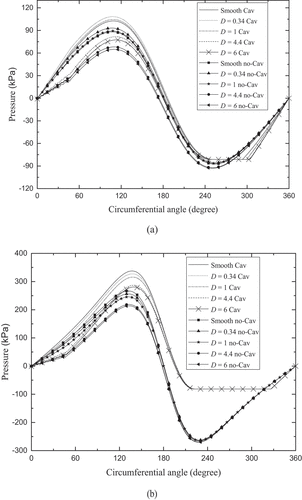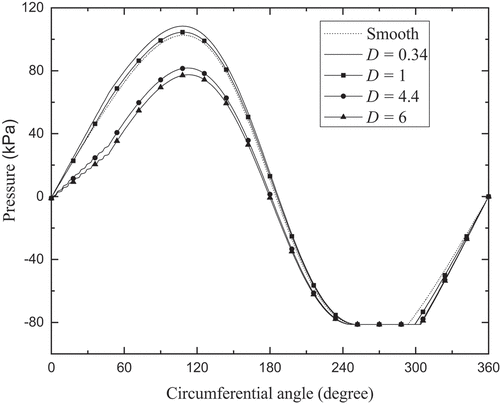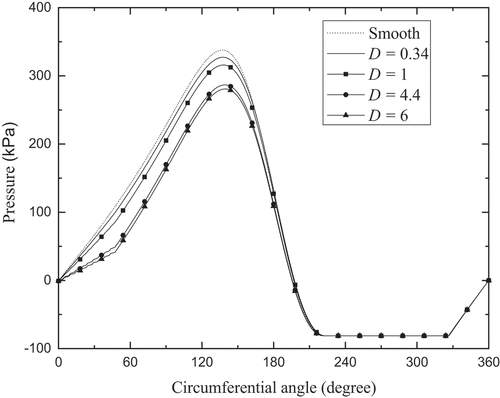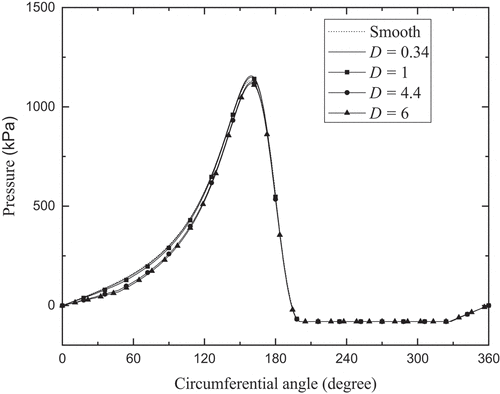 ?Mathematical formulae have been encoded as MathML and are displayed in this HTML version using MathJax in order to improve their display. Uncheck the box to turn MathJax off. This feature requires Javascript. Click on a formula to zoom.
?Mathematical formulae have been encoded as MathML and are displayed in this HTML version using MathJax in order to improve their display. Uncheck the box to turn MathJax off. This feature requires Javascript. Click on a formula to zoom.Abstract
Lubricated contact performance can be improved by using a textured surface as well as a hydrophobic surface. A procedure to obtain the optimal partially textured journal bearing combined with the hydrophobic coating is presented through the computational fluid dynamics (CFD) codes. In this study, lubricated hydrophobic textured contacts with and without cavitation modeling are discussed. The cavitation phenomena in the lubricant is modeled using a multiphase model of “mixture” to obtain a realistic condition. The effect of dimple depth, as well as the eccentricity ratio, on the tribological performance, is of particular interest. It is found that the tribological performance is greatly influenced by the multiphase flow cavitation scheme. When cavitation modeling is taken into account, higher load support is noted. Furthermore, the simulation results show that a hydrophobic textured surface with a shallow depth (d/hmin<1) seems to be better for enhancing the tribological performance. Meanwhile, for the case of the low eccentricity ratio, there is an optimal dimple depth giving the highest load support. The findings explored in this work can be considered as a theoretical basis to increase the performance of hydrophobic textured journal bearing.
PUBLIC INTEREST STATEMENT
In recent years, it has been demonstrated that surface modification, such as surface texturing and the addition of a hydrophobic coating, will result in improved bearing performance. In this study, the beneficial effect of hydrophobic coating on the textured bearing performance is numerically examined. Additionally, how to accurately simulate certain phenomena (in this example, cavitation) during lubrication has been presented. Furthermore, the optimal texturing parameters have also been discussed. The results of this study can be used as a theoretical foundation for obtaining high performance of journal bearings.
1. Introduction
Journal bearings are crucial components that are widely installed in propulsions and industrial applications. Some parameters, such as the lubricants temperature (Benzeguir et al., Citation2014) and bearing shape (Faria, Citation2014), have an impact on the performance of journal bearings. Furthermore, over the last decades, numerous investigations have aimed at enhancing the performance of journal bearing by exploiting developing technologies, such as surface texturing and the use of slipping domains.
There have been a large number of workers focusing on surface texturing as a viable engineering method due to their helpfulness to enhance the bearing performance. It is worth highlighting the early work of Etsion and his group who showed that textured surfaces improve load support and decrease hydrodynamic friction in a variety of applications, including mechanical seals (Etsion & Halperin, Citation2002), reciprocating (cylinder-liner) contacts (Ryk et al., Citation2002), and thrust bearing (Etsion et al., Citation2004). Subsequently, numerous studies have now been published in the literature supporting this finding. To enhance the performance of journal bearing, Shinde and Pawar (Citation2017) studied the optimal surface texturing parameters using the multi-objective optimization approach. Focusing on reducing the frictional performance of journal bearings, Grützmacher et al. (Citation2018) explore the influence of single-scale and multi-scale surface patterns designed and manufactured onto the shaft of stainless steel journal bearings. The results indicated that the patterned surfaces can reduce the coefficient of friction over the entire range of rotational speeds. In terms of acoustic performance, Meng and Zhang (Citation2018) showed the positive effect of the compound groove in lowering the bearing noise. Lin et al. (Citation2018) revealed that a journal bearing’s surface texture can either increase or degrade its load support generation ability. Later, Meng et al. (Citation2019) experimentally studied the texturing effect on acoustic performance. It was found that reduced noise is obtained by introducing the compound dimple. Vlădescu et al., (Citation2015, Citation2019) demonstrated the experimental study regarding the influence of texturing on reducing friction. It was highlighted that the texturing of bearing engineered to the whole of its circumference leads to lower friction up to 18%-50% in comparison with the smooth domain. Galda et al. (Citation2019) revealed when textured journal bearings were shut down, they remained in hydrodynamic lubrication for a longer period and transitioned to mixed lubrication at lower speeds than smooth journal bearings. Further, Tomar and Sharma (Citation2020) found that by incorporating a spherical micro-dimple onto the bearing surface, the stability parameter is increased, while frictional loss is decreased in comparison to a non-textured hybrid spherical journal bearing. Manser et al. (Citation2019) revealed that texturing the bearing convergence zone considerably boosts load support and minimizes friction coefficient, however, fully texturing the bearing convergent zone results in poor performance. In mixed-elastohydrodynamic simulations, König et al. (Citation2020) showed the biggest decrease in friction of journal bearing by 80 % when using real 3D surface topographies. Recently, Shen et al. (Citation2021) reported a method for further enhancing the chevron textured surface’s lubrication performance. Filho et al. (Citation2021) conducted an experimental analysis on a journal bearing with four distinct texture patterns: chevron, sawtooth, oblong dimple, and aligned dimple. The authors indicated that the chevron and oblong dimple patterns have the greatest effect on the parameters studied. According to the literature mentioned, many questions addressing the optimal design of surface textures, as well as their positive and negative effects on component performance, remain unanswered. To address this issue, Rosenkranz et al. (Citation2019) presented an engaging discussion on the state of the art in machine element surface texturing. In more recent work, the same author (Rosenkranz et al., Citation2021) explored an interesting review for enhancing tribological performance in dry conditions. They concluded that combining surface textures and solid lubricants is an intriguing method that has the potential to induce synergistic effects, dramatically decreasing friction and wear.
Along with surface topography (designed surface textures), surface chemistry (designed chemical patterns) has garnered considerable interest in improving the performance of lubricated contacts (Grützmacher et al., Citation2021; Senatore & Rao, Citation2018). As one of the approaches based on surface chemistry, the application of (super)hydrophobic material to lubricated contacts has gained substantial attention. The use of (super)hydrophobic coating may fail the no-slip condition assumption. The generated slip boundary due to the utilization of the hydrophobic coatings can have a helpful or detrimental influence on the tribological performance of bearings, depending on the hydrophobic material placement. If the coating is applied in full slip configuration on the bushing, the decreased load support of the lubricated journal bearing was observed as demonstrated by Zhang et al. (Citation2014). According to the literature, for example, Tauviqirrahman etal. (Citation2013), Savio et al. (Citation2018), and Cui etal., (Citation2020), the increased bearing performance, that is, high load support but low friction, can be accomplished by engineering a surface in such a way that slip occurs in certain regions but not in others. In the other words, to obtain the beneficial slip effect, the location of the hydrophobic coating must be carefully determined.
Recently, to enhance the tribological performance of the bearing, some workers have explored the potential technique to combine the hydrophobic material with surface texturing. Susilowati et al. (Citation2016) based on the Reynolds approach demonstrated that combining slip and texturing approaches significantly improve the tribological performance of bearings, i.e., high load support with a minimal friction force. Zhao and Jianxi (Citation2020) revealed that the friction resistance is greatly reduced when the interfacial slip is combined with the texture. With the inclusion of the cavitation model, Muchammad et al. (Citation2021) analytically studied the effect of the pocket on the pressure generation using the modified Reynolds equation. It was also found that the pocket depth reduces the cavitation area. Furthermore, according to numerical analyses, the position and size of the slip and texturing zone have a significant impact on journal bearings (Jin et al., Citation2021, Lin et al., Citation2015).
To improve the accurate prediction of journal bearings, many studies have been performed focusing on the cavitation effect on the bearing performance with a variety of cavitation models. Mao et al. (Citation2016), based on the analytical model, explored the cavitation performance at various textures. Sun et al. (Citation2019) investigated the effect of cavitation on the static and dynamic characteristics of bearing. Using the Jakobsson-Floberg-Olsson (JFO) cavitation boundary, Ramos and Daniel (Citation2020) showed that due to the cavitation effect, the stability threshold is changed in a journal bearing. Besides, cavitation has a substantial association with film formation and coefficient of friction, as demonstrated experimentally by Bulut et al. (Citation2021). Recently, when hydrophobic coatings become popular, the interplay between slip induced by (super)hydrophobic material and cavitation has been widely reported by Wang and Lu (Citation2015), Jamari et al. (Citation2019), and Biancofiore et al. (Citation2019). In their works, the mass conserving cavitation models have been employed. Additionally, along with the complexity of the flow inside journal bearing, there is a need to predict the change tendency of the phase of the bearing in which in most of the previously published literature, the phase change has not been considered.
An extensive literature survey revealed that the studies focused on the cavitation treatment in the textured bearing with/without hydrophobic still adopts the single-phase model. Besides, based on the single-phase cavitation model, the performance is still not satisfactorily predicted. Starting from this point, the novelty of the present study contains the tribological analysis of a textured bearing combined with a hydrophobic pattern considering the effect of multiphase cavitation. The present work is focused on optimizing texture geometry for hydrophobic journal bearing and exploring its dependency on the cavitation phenomena. Moreover, the simulation results of the flow behavior are improved by taking advantage of the “mixture” multiphase model. This model solves the mass conservation and momentum conservation equations and the equation of the volume fraction for the vapor phase. Further, the analysis of the significance of the inclusion of the cavitation model is also carried out. Finally, related conclusions are presented.
2. Method
2.1. Geometry
Numerous findings, for example, Tala-Ighil et al. (Citation2011), Brizmer and Kligerman (Citation2012), Vlădescu et al., (Citation2015, Citation2019) and Manser et al. (Citation2019) indicate that partial texturing should be used to increase load support and decrease the coefficient of friction. Inspired by this finding, Figure shows the journal bearing geometry studied here which comprises a hydrophobic textured area applied at the inlet of the contact. The surface texturing adopted from the work of Cupillard et al. (Citation2008) consists of 10 dimples with a circle shape. As reflected in Figure ), a simple cell is identified by its depth (d) and width (Wtexture). Here, the hydrophobic coating is applied on all dimple edges of the textured area. The dimple is applied at θ = 0° (measured from the maximum film thickness) to θ = 48°. In this analysis, the dimensionless dimple depth, D, is of particular interest to obtain the optimal texture parameter. The dimensionless dimple depth (D) is defined in this context as the ratio of the dimple depth (d) to the minimum film thickness (hmin). The values of D (D= d/hmin) are varied to 0.34, 1, 4.4, and 6. The main fixed factors of the bearing system and the appropriate primary lubricant characteristics are shown in Table . Song et al. (Citation2017) used a numerical technique to demonstrate the effect of turbulence on bearing performance. They found that it is vital to assess the influence of turbulence, especially when the slip condition is present. Therefore, in this analysis, the turbulence effect has been included based on the realizable k-ε model.
Figure 1. (a) Representation of partially textured hydrophobic bearing system, (b) two-dimensional dimple texture combined with hydrophobic material.
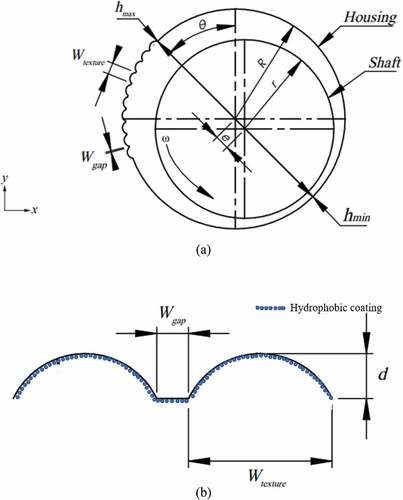
Table 1. Calculation set for analysis
For the analysis, the cosine profile representing the distribution of the film thickness is used, as depicted in Figure . The boundary condition is specified as follows in this simulation: the maximum film thickness is employed on one side as an inlet and the other as an outlet. At the inlet and outlet boundaries, the pressure is assumed to be zero, i.e., ambient pressure. The lubricant film’s upper surface is simulated as a stationary wall, while the lower surface is modeled as a moving wall rotating at the same rate as the shaft. The regions of cavitation and the pressure profile are computed by the MIXTURE model during the simulation in ANSYS FLUENT® software.
2.2. Governing equations
For all following computations, the conservation equations (i.e., Navier-Stokes and Continuity) for steady, incompressible flow, with external body force and zero gravitational are:
where p refers to the pressure (Pa), η denotes the dynamic viscosity of the lubricant (Pa.s) and u refers to the vector of lubricant velocity (m/s)
For hydrodynamic lubrication, the hydrophobicity of the surface is critical in determining slip boundary. Choosing a model for the slip boundary is the greatest issue for a hydrophobic surface in terms of numerical modeling. In the present study, the Navier-slip model is adopted to obtain the slip velocity of the hydrophobic pattern. It reads:
where us refers to the slip velocity at which the hydrophobic condition is introduced, b reflects the slip length and denotes the shear rate of the surface. Here, a slip length is set to 100 μm since such value gives the optimal behavior of hydrophobicity.
In the present study, CFD (computational fluid dynamics) approach is adopted to solve the lubricant flows in the textured journal bearing. The user-defined function (UDF) is built to model the hydrophobic characteristic. ANSYS Fluent, a CFD software, is used for numerical lubricant simulations.
To describe the cavitation characteristics in the journal bearing, the mixture multiphase model is adopted. In the divergent zone of the bearing, a broad distribution of the vapor phase may be found. Therefore, the mixture model is quite appropriate for higher vapor volume fractions with less expensive computational efforts.
In this work, the Zwart–Gelber–Belamri model is adopted to capture the phase change through the whole fluid field. This model is chosen due to its higher precision and robustness (ANSYS, Inc, Citation2017). Based on the mixture model, vapor transport can be calculated by (ANSYS, Inc, Citation2017):
where αv refers to the volume fraction of the vapor, ρv denotes the density of the vapor, while Rg and Rc denote transferring cavitation bubbles referring to the growth and collapse of the vapor bubbles respectively. For the Zwart–Gelber–Belamri model, the mass transfer equation for evaporation and condensation are shown below (ANSYS, Inc, Citation2017):
where RB refers to bubble radius, αnuc represents nucleation site volume fraction, Fevap denotes evaporation coefficient, and Fcond refers to condensation coefficient. It should be noted that the default values of the CFD solver were applied to all parameters of the mass transfer equation.
2.3. Simulation setup
Before resolving the bearing performance, it is necessary to mesh the lubrication film. A two-dimensional mesh of hexahedral is used to discretize the spatial domain. Thus, the grid system may reduce the relative percentage difference between the simulation result and the actual result to less than 2% at the convergence requirements for the velocity parameter (1.0x10−6), which is sufficient for engineering calculations, particularly bearing calculations. Additionally, further refining of the grid system is conducted to achieve mesh independence. In this work, the independent mesh size employed in the following scenarios ranges between 90,000 and 110,000 nodes, depending on the groove depth.
The pressure-based solver is used in the current numerical analysis. The SIMPLEC algorithm is used to solve the pressure–velocity coupling, while the second-order upwind discretization approach is used to solve the momentum equations. The QUICK discretization scheme is used to compute the volume fraction equation, the turbulent kinetic energy, and the turbulent dissipation rate. To obtain more precise results, all residual terms are subjected to a convergence tolerance of 1 × 10−6.
3. Results and discussion
3.1. Validation
To ensure that the simulation results are accurate, the developed CFD code is validated based on the previously published study of Cupillard et al. (Citation2008). The bearing geometry, as well as other main parameters, are the same as the published work in Cupillard et al. (Citation2008). It can be observed in Figure that the simulation result of the present work is basically in good accordance with the work of Cupillard et al. (Citation2008). The deviation of the value of the peak pressures between the two analyses may be due to the flow model used. In our study, the turbulent model is adopted while in the reference, the laminar model was employed. According to Song et al. (Citation2017), the turbulence effect increases the maximum pressure, and hence it can be ignored. Besides, in our work, the independent mesh of the computational domain is 20% finer than the mesh employed in the reference. However, the simulation result shows that the deviation is just around 3 %. It indicates that the method chosen here is acceptable for the following simulations because it can catch the hydrodynamic behavior accurately.
Figure 3. Hydrodynamic pressures predicted by the present study and Cupillard et al. (Citation2008)
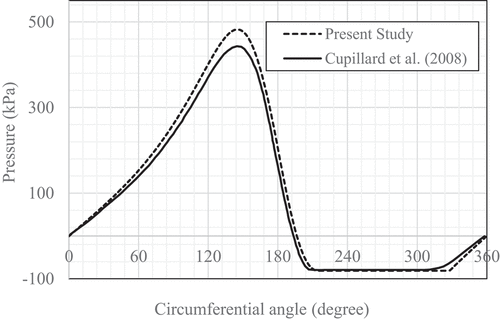
3.2. Effect of Cavitation
In this section, the behavior of the hydrophobic textured journal bearing considering the phenomena of the oil film rupture is examined. In this study, the characteristic of multi bubble dynamics is considered during the calculation for the more accurate representation of the cavitation.
In order to quantify the cavitation modeling capability, the circumferential pressure for hydrophobic textured systems has been compared varying the dimple depths at different eccentricity ratios as reflected in Figure . The presented results have been acquired for low loading (ε = 0.2), medium loading (ε = 0.5), and high loading (ε = 0.8). Here, two distinct types of analyses are presented, namely, those using the multiphase cavitation model and those involving no cavitation modeling. It can be found from Figure that as a whole, taking into account the cavitation model, regardless of the dimple depth utilized, the pressure peak becomes higher than without the cavitation model. The results with different three eccentricity ratios considered here show a similar trend, based on Figure , Figure . However, specifically, as shown in Figure , the maximum deviation of predicted pressure distribution between the two approaches is more observed when the high ε is employed. It leads to the conclusion that the cavitation modeling is extremely sensitive to the pressure build-up characteristics of the bearing system. This is to say that by considering the cavitation model, a more realistic situation of the bearing performance can be achieved. For example, the cavitation zone, which occurs in the divergent area, seems bigger for the case of a high eccentricity ratio ε. Obviously, without considering the cavitation, the non-realistic of pressure profiles are observed. Generally speaking, the higher the eccentricity ratio, the longer the cavitation area.
3.3. Effect of texture depth
As discussed earlier, cavitation is one of the factors altering the flow characteristics of the bearing dramatically. Therefore, in this section, the real situation dealing with the occurrence of cavitation is employed in the numerical simulations. A “mixture” multiphase cavitation model adopted here justifies more realistic conditions and thus more accurate results of the simulation (Cupillard et al., Citation2008).
The pressure distribution of hydrophobic textured bearings at different dimple depths for the low eccentricity ratio ε is reflected in Figure . Here, in order to justify the benefits of the texturing application combined with the hydrophobic coating, the film pressure is also presented for the smooth (un-textured) bearing. The simulation results show that for shallow dimples (in this case D = 0.34 and 1), the pressure profiles, as well as the peak pressure, are slightly higher than the smooth bearing. It means that by texturing the surface, the higher pressure peak can make the oil load-support increase and provide superior lubrication compared to smooth ones. However, for deep dimple, that is, D = 4.4 and 6, the texturing gives the reduced peak pressure in comparison with the smooth one.
As clearly reflected from Figure , with respect to the length of the cavitation area, specifically for this eccentricity ratio (ε = 0.2 in this case), for the textured case, dimples that lift the pressure curve result in a somewhat bigger cavitation area compared to the smooth case. However, the difference in the cavitation area is not so significant. In the other words, the dimple depth has little effect on the length of the cavitation zone but has a great impact on the peak pressure. This finding is in good agreement with the work of Mao et al. (Citation2016). By establishing an analytical cavitation model, they highlighted that the length of the cavitation region expands slightly as the depth ratio increases. For reference to the design of the hydrophobic textured journal bearing system, the hydrophobic textured surface with the lowest dimple depth is advisable to obtain more additional load support.
A different result of the pressure profile is observed in the case of ε = 0.5, as shown in Figure . The simulation results show that presenting the texturing tends to decrease the peak pressure as observed in the convergent area. In comparison to the smooth (untextured) bearing, all profiles of the textured bearing become lower, indeed much lower for a deep dimple. Concerning the cavitation phenomenon, the texturing produces the same behavior as the smooth one. It indicates that texturing the bearing surface under the operating condition of ε = 0.5, does not change the cavitation characteristics in the divergent region.
What about the effect of texturing in the case of high loading? In order to answer this question, the simulations have also been conducted for the high eccentricity ratio, and the results are presented in Figure . An interesting result is noted; with the increase in the eccentricity ratio, the effect of texturing irrespective of the dimple depth can be broken down. Here, the observed characteristic of the hydrophobic textured bearing system is the same as the smooth one. From the tribological point of view, it indicates that there is a value point of eccentricity ratio in which if this threshold is exceeded, the performance of the bearing induced by texturing tends to increase to the point leading to a similar action of the smooth bearing.
Regarding with hydrophobic texturing effect under different eccentricity ratios, it can be observed that the positive effect of texturing in the presence of the hydrophobic coating is more pronounced for a low eccentricity ratio. The current findings are comparable to the results of pure texturing (without hydrophobic coating) as demonstrated by previous studies, such as Cupillard et al. (Citation2008), Brizmer and Kligerman (Citation2012), F. M. Meng et al. (Citation2015), Sharma et al. (Citation2016), and Zhang et al. (Citation2018). It was worth noting that the benefit of texturing in improving the hydrodynamic pressure profile and hence load support appears to gradually decrease as the eccentricity ratio increases. Dimples, therefore, lose their ability to increase load support and, in fact, decrease it. It suggests that a higher bearing eccentricity ratio usually results in just a slight increase in load support.
3.4. On tribological performance
In this section, the influence of texture depth on the tribological performance of the hydrophobic textured bearing systems is summarized in Figure and Figure in terms of the generation of the load support and the bearing friction. During the calculation process, deep attention is being paid to the cavitation effect by comparing two approaches (i.e., “including the multiphase cavitation approach” versus “without considering the cavitation model”).
Figure 8. Comparison of load support between “with cavitation” and “without cavitation” analysis for (a) ε = 0.2, (b) ε = 0.5, (c) ε = 0.8.
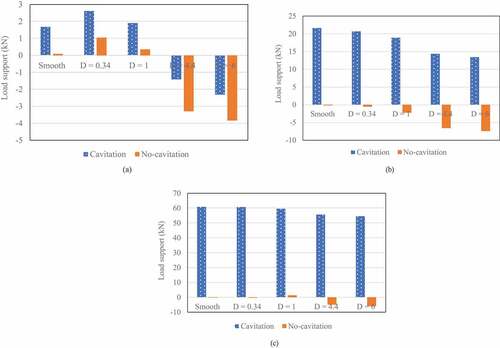
Figure 9. Comparison of load support between “with cavitation” and “without cavitation” analysis for (a) ε = 0.2, (b) ε = 0.5, (c) ε = 0.8.
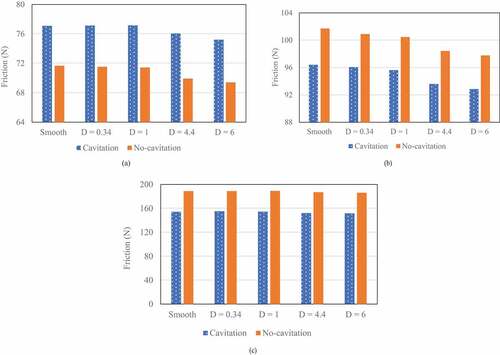
Careful planning is needed in the design process of the hydrophobic textured bearing. The load-carrying support of the bearing is evaluated by taking the integration of the film pressure acting on the bearing system. Increased load support will lead to the good behavior of bearing in extreme loading situations. Therefore, in this analysis, the eccentricity ratio ε is considered to vary from 0.2, 0.5, and 0.8, representing the condition of lightly loaded bearing, medium loaded bearing, and heavily loaded bearing, respectively. Meanwhile, the friction is calculated by the integration of the shear stress over the surface. Low friction could be positive property and be beneficial in expanding the usable operational velocity range of the journal bearing.
Figure illustrates a comparative study of the load support under various surface patterns with and without cavitation modeling. For a low eccentricity ratio (ε = 0.2 in this case), it is found that hydrophobic textured bearing with dimensionless dimple depth D = 0.34 gives the highest load support. Based on simulated results, the reduced load support is observed to be more significant when the dimple depth is increased. In fact, the texture depth of D = 4.4, as well as D = 6, gives the failure of lubrication. As a note, the negative value of load support, as reflected in Figure , reveals that lubrication failure is observed from the stability point of view. The corresponding explanation for why it occurs in the case of ε = 0.2 is because the positive pressure profile in the convergent area is not enough to counterbalance the negative pressure in the divergent area due to cavitation, as reflected in Figure . As a result, the pressure integration along the contact surface in creating the load support vanishes. Even for the situations with larger dimple depth (D = 4.4 and D = 6 in this case), load support becomes negative. This result seems to be consistent with the performance of the dimpled surface without hydrophobic coating. According to Liang et al. (Citation2016), in the case of partial textured sliding journal bearing as examined here, the influence of shallow dimples outperforms that of deep dimples. Besides, due to the small eccentricity ratio (ε = 0.2 in this case), the low wedge effect does not appear to be able to compensate for the detrimental effect of cavitation. In the case of texturing with a larger D, the inertia is more pronounced. According to Dobrica and Fillon (Citation2009), it was demonstrated that inertia has a negative influence on the load capacity of the bearing, which is particularly evident in the case of partially textured contact, as explored here. As illustrated in Figure , the combined effect of the small wedge effect and inertia causes the predicted load support to become severe in the case of D = 4.4 and D = 6.
Further, the numerically simulated results in Figure show that in terms of the load support, for ε = 0.5 and ε = 0.8, the effect of texture depth gives a similar trend. The load-carrying support tends to reduce with increasing dimple depth. For this condition, it may be noticed that the traditional (no-slip untextured) journal gives a better performance than the hydrophobic textured bearing. This finding is very identical to the case of purely textured bearing. As demonstrated by Y. Zhang et al. (Citation2019), texture depth can only increase bearing performance to a certain extent.
The effect of dimple depth in different analysis approaches is reflected in Figure under different eccentricity ratios. For the case of a low eccentricity ratio (Figure ), with an increase in D, the friction tends to reduce. The decrease in friction becomes significant when the high dimple depth is employed. Because the dimples enhance the thickness of the film, they minimize the shear stress at the interface, which in turn reduces friction. Again, this trend is comparable to the results of purely textured bearing as discussed by Cupillard et al. (Citation2008) and Tala-Ighil et al. (Citation2011) concluding that the friction decreases with an increase in nondimensional texture depth. Meanwhile, for the case of ε = 0.5, similar behavior of the friction trend is observed. The main difference is that when the multiphase cavitation modeling is taken into account, the friction calculated is higher than the ones predicted by the “no-cavitation” analysis. For ε = 0.8, the friction does not change with the increase in D. The reason behind this is due to the wedge effect caused by the high eccentricity ratio. This effect has a more dominant role compared to the texture effect. In Figure ), Figure ), the dimple depth D of 6 leads to positive effects on hydrodynamic behavior by reducing the friction force. A reduction of up to 4 % in the friction coefficient is observed. Therefore, in terms of friction, it is better to set the dimple depth at the higher value, instead of the lower value, especially in the case of the lower eccentricity ratio. However, in the design of the bearing, all of the tribological performance indicators must be carefully considered, not just friction. According to Figure ), Figure ), the highest load support is achieved when the textured bearing with D of 0.35 is chosen. In comparison to the traditional (untextured) bearing, an increment of 50% is found. As discussed earlier, it seems that when the ε is increased, the load support is still high as the smooth bearing. Generally speaking, concerning the load support and the friction, the textured bearing with D of 0.35 is recommended to employ, especially for the low loading, because it leads to the improved load support but the low friction.
4. Conclusions
In this work, the journal bearing with hydrophobic partial texturing was investigated through the computational fluid dynamics (CFD) approach. The dimple with circle shape applied at the oil-wedge region is of particular interest varying the dimple depths. The improved hydrophobic journal bearing with texturing is obtained by optimizing the dimple depth under different eccentricity ratios, and the cavitation based on the multiphase approach is taken into account. The key conclusions can be drawn as follows:
Effect of cavitation could be taken into account through adopting the mixture multiphase flow approach. The validity of this model is verified by the published numerical result.
For journal bearings with the eccentricity ratios and dimple depths specified here, the multiphase flow cavitation approach is highly significant. When the cavitation modeling is considered, higher load support is observed for all cases.
With an increasing eccentricity ratio, the increasing rate of bearing load appears to gradually decrease. For a high eccentricity ratio, the beneficial effect of texturing can vanish, and its performance is similar to the smooth bearing.
For medium and high eccentricity ratios, the load support performance of hydrophobic textured bearing decreases with the increase in the dimple depth. For a low eccentricity ratio, there is an optimal dimensionless dimple depth corresponding to the largest ultimate load support.
The textured bearing with a dimensionless dimple depth of 0.35 is recommended for usage, particularly at low loads, because it provides enhanced load support while maintaining minimal friction.
Nomenclature
bSlip length (µm)
c Bearing clearance (mm)
d Dimple depth (mm)
D Dimensionless dimple depth (D=d/hmin)
e Eccentricity distance (mm)
hmax Maximum film thickness (mm)
hmin Minimum film thickness (mm)
L Bearing length (mm)
p Hydrodynamic pressure (Pa)
Pv Saturation pressure of vapor (Pa)
R Housing radius (mm)
RB Bubble radius (mm)
r Shaft radius (mm)
U Sliding velocity (m/s)
usSlip velocity (mm/s)
Wgap Length of texture valley (o)
Wtexture Length of texture cell (o)
αnuc Nucleation site volume fraction(-)
αv Vapor volume fraction (-)
εEccentricity ratio(ε = e/c)
ρLubricant density (kg/m3)
ρv Density of lubricant vapor (kg/m3)
ηLubricant viscosity (Pa.s)
ηv Viscosity of lubricant vapor (Pa-s)
ωRotational velocity (rad/s)
θCircumferential angle (o)
Acknowledgements
.The authors fully acknowledged Institute for Research and Community Services (LPPM), Diponegoro University for the approved fund, which makes this important research viable and effective.
Disclosure statement
No potential conflict of interest was reported by the author(s).
Additional information
Funding
Notes on contributors
Mohammad Tauviqirrahman
Mohammad Tauviqirrahman is Senior Lecturer and Head of Laboratory for Engineering Design and Tribology at the Engineering Faculty, Diponegoro University, Semarang, Cental Java, Indonesia. He completed his B.Eng (Diponegoro University, 2003), M.Eng (Institut Teknologi Bandung, 2006) and Doctoral degree (Twente University, the Netherlands, 2013). His research interests include tribology (in lubricant and surface modification), and computational fluid dynamics (CFD). He has published over 66 refereed papers and 69 conference papers. His publications have been cited over 419 times for H index of 10. As a note, the paper published here is a part of the project “Green Technology for Bearing”, in the roadmap of the research in Laboratory for Engineering Design and Tribology.
References
- ANSYS, Inc. (2017). ANSYS fluent manual guide, release 18.0. SDC Publications.
- Benzeguir, R., Rezini, D., Tala Ighil, N., & Bounif, A. (2014). Contribution to thermo-hydrodynamic study of journal bearing under a stationary load. International Journal on Heat and Mass Transfer - Theory and Applications, 2(5), 178–17. https://www.praiseworthyprize.org/jsm/index.phpjournal=ireheat&page=article&op=view&path%5B%5D=261
- Biancofiore, L., Giacopini, M., & Dini, D. (2019). Interplay between wall slip and cavitation: A complementary variable approach. Tribology International, 137, 324–339. https://doi.org/10.1016/j.triboint.2019.04.040
- Brizmer, V., & Kligerman, Y. (2012). A laser surface textured journal bearing. Journal of Tribology, 134(3), 031702. https://doi.org/10.1115/1.4006511
- Bulut, D., Bader, N., & Poll, G. (2021). Cavitation and film formation in hydrodynamically lubricated parallel sliders. Tribology International, 162, 107113. https://doi.org/10.1016/j.triboint.2021.107113
- Cui, S., Zhang, C., Fillon, M., & Gu, L. (2020). Optimization performance of plain journal bearings with partial wall slip. Tribology International, 145, 106137. https://doi.org/10.1016/j.triboint.2019.106137
- Cupillard, S., Glavatskih, S., & Cervantes, M. J. (2008). Computational fluid dynamics analysis of a journal bearing with surface texturing. Proceedings of the Institution of Mechanical Engineers, Part J: Journal of Engineering Tribology, 222(2), 97–107. https://doi.org/10.1243/13506501JET319
- Dobrica, M. B., & Fillon, M. (2009). About the validity of Reynolds equation and inertia effects in textured sliders of infinite width. Proceedings of the Institution of Mechanical Engineers, Part J: Journal of Engineering Tribology, 223(1), 69–78. https://doi.org/10.1243/13506501JET433
- Etsion, I., & Halperin, G. (2002). A laser surface textured hydrostatic mechanical seal. Tribology Transactions, 45(3), 430–434. https://doi.org/10.1080/10402000208982570
- Etsion, I., Halperin, G., Brizmer, V., & Kligerman, Y. (2004). Experimental investigation of laser surface textured parallel thrust bearing. Tribology Letters, 17(2), 295–300. https://doi.org/10.1023/B:TRIL.0000032467.88800.59
- Faria, M. T. C. (2014). Comparative performance analysis of gas lubricated cylindrical and elliptical journal bearings. International Review of Mechanical Engineering, 8(5), 901–907. https://doi.org/10.15866/IREME.V8I5.2985
- Filgueira Filho, I. C. M., Bottene, A. C., Silva, E. J., & Nicoletti, R. (2021). Static Behavior of Plain Journal Bearings with Textured Journal - Experimental Analysis, Tribology International, 159, 106970. https://doi.org/10.1016/j.triboint.2021.106970
- Galda, L., Sep, J., Olszewski, A., & Zochowsk, T. (2019). Experimental investigation into surface texture effect on journal bearings performance. Tribology International, 136, 372–384. https://doi.org/10.1016/j.triboint.2019.03.073
- Grützmacher, P. G., Rosenkranz, A., Szurdak, A., König, F., Jacobs, G., Hirt, G., & Mücklich, F. (2018). From lab to application - Improved frictional performance of journal bearings induced by single- and multi-scale surface patterns. Tribology International, 127, 500–508. https://doi.org/10.1016/j.triboint.2018.06.036
- Grützmacher, P. G., Jalikop, S. V., Gachot, C., & Rosenkranz, A. (2021). Thermocapillary lubricant migration on textured surfaces - A review of theoretical and experimental insights. Surface Topography: Metrology and Properties, 9, 013001. https://doi.org/10.1088/2051-672X/abd07c
- Jamari, J., Muchammad, M., Hilmy, F., & Tauviqirrahman, M. (2019). Effect of inertia on the cavitation phenomena of hydrodynamic textured bearings considering slip. Journal of the Brazilian Society of Mechanical Sciences and Engineering, 41(9), 387. https://doi.org/10.1007/s40430-019-1890-9
- Jin, J., Chen, X., Fu, Y., & Chang, Y. (2021). Optimal design of the slip–texture on a journal-bearing surface. Industrial Lubrication and Tribology, 73(2), 230–237. https://doi.org/10.1108/ILT-01-2020-0022
- König, F., Rosenkranz, A., Grützmacher, P. G., Mücklich, F., & Jacobs, G. (2020). Effect of single- and multi-scale surface patterns on the frictional performance of journal bearings – A numerical study. Tribology International, 143, 106041. https://doi.org/10.1016/j.triboint.2019.106041
- Liang, X., Liu, Z., Wang, H., Zhou, X., & Zhou, X. (2016). Hydrodynamic lubrication of partial textured sliding journal bearing based on three-dimensional CFD. Industrial Lubrication and Tribology, 68(1), 106–115. https://doi.org/10.1108/ILT-04-2015-0055
- Lin, Q., Wei, Z., Wang, N., & Chen, W. (2015). Effect of large-area texture/slip surface on journal bearing considering cavitation. Industrial Lubrication and Tribology, 67(3), 216–226. https://doi.org/10.1108/ILT-05-2013-0055
- Lin, Q., Bao, Q., Li, K., Khonsari, M. M., & Zhao, H. (2018). An investigation into the transient behavior of journal bearing with surface texture based on fluid-structure interaction approach. Tribology International, 118, 246–255. https://doi.org/10.1016/j.triboint.2017.09.026
- Manser, B., Belaidi, I., Hamrani, A., Khelladi, S., & Bakir, F. (2019). Performance of hydrodynamic journal bearing under the combined influence of textured surface and journal misalignment: A numerical survey. Comptes Rendus Mécanique, 347(2), 141–165. https://doi.org/10.1016/j.crme.2018.11.002
- Manser, B., Belaidi, I., Khelladi, S., Chikh, M. A. A., Deligant, M., & Bakir, F. (2020). Computational investigation on the performance of hydrodynamic micro-textured journal bearing lubricated with micropolar fluid using mass-conserving numerical approach. Proceedings of the Institution of Mechanical Engineers, Part J: Journal of Engineering Tribology, 234(8), 1310–1331. https://doi.org/10.1177/1350650119894167
- Mao, Y., Zeng, L., & Lu, Y. (2016). Modeling and optimization of cavitation on a textured cylinder surface coupled with the wedge effect. Tribology International, 104, 212–224. https://doi.org/10.1016/j.triboint.2016.09.002
- Meng, F. M., Zhang, L., Liu, Y., & Li, T. T. (2015). Effect of compound dimple on tribological performances of journal bearing. Tribology International, 91, 99–110. https://doi.org/10.1016/j.triboint.2015.06.030
- Meng, F. M., & Zhang, W. (2018). Effects of compound groove texture on noise of journal bearing. Journal of Tribology, 140(3), 031703. https://doi.org/10.1115/1.4038353
- Meng, F., Yu, H., Gui, C., & Chen, L. (2019). Experimental study of compound texture effect on acoustic performance for lubricated textured surfaces. Tribology International, 133, 47–54. https://doi.org/10.1016/j.triboint.2018.12.036
- Muchammad, M., Tauviqirrahman, M., Jamari, J., & Schipper, D. J. (2021). Analysis of the effect of the slip-pocket in single and double parallel bearing considering cavitation: A theoretical approach. Lubricants, 9(1), 3. https://doi.org/10.3390/lubricants9010003
- Ramos, D. J., & Daniel, G. B. (2020). Evaluation of bearing’s cavitation effects on the rotor dynamic behavior. Applied Mathematical Modelling, 77(1), 49–65. https://doi.org/10.1016/j.apm.2019.07.026
- Rosenkranz, A., Grützmacher, P. G., Gachot, C., & Costa, H. L. (2019). Surface texturing in machine elements − a critical discussion for rolling and sliding contacts. Advanced Engineering Materials, 21(8), 1900194. https://doi.org/10.1002/adem.201900194
- Rosenkranz, A., Costa, H. L., Baykara, M. Z., & Martini, A. (2021). Synergetic effects of surface texturing and solid lubricants to tailor friction and wear – A review. Tribology International, 155, 106792. https://doi.org/10.1016/j.triboint.2020.106792
- Ryk, G., Kligerman, Y., & Etsion, I. (2002). Experimental investigation of laser surface texturing for reciprocating automotive components. Tribology Transactions, 45(4), 444–449. https://doi.org/10.1080/10402000208982572
- Savio, D., Falk, K., & Moseler, M. (2018). Slipping domains in water-lubricated microsystems for improved load support. Tribology International, 120, 269–279. https://doi.org/10.1016/j.triboint.2017.12.030
- Senatore, A., & Rao, T. V. V. L. N. (2018). Partial slip texture slider and journal bearing lubricated with Newtonian fluids: A review. Journal of Tribology, 140(4), 040801. https://doi.org/10.1115/1.4039226
- Sharma, N., Kango, S., Tayal, A., Sharma, R. K., & Sunil, R. K. (2016). Investigations on the influence of surface texturing on a couple stress fluid–based journal bearing by using JFO boundary conditions. Tribology Transactions, 59(3), 579–584. https://doi.org/10.1080/10402004.2015.1094840
- Shen, Z., Wang, F., Chen, Z., Ruan, X., Zeng, H., Wang, J., An, Y., & Fan, X. (2021). Numerical simulation of lubrication performance on chevron textured surface under hydrodynamic lubrication. Tribology International, 154, 106704. https://doi.org/10.1016/j.triboint.2020.106704
- Shinde, A. B., & Pawar, P. M. (2017). Multi-objective optimization of surface textured journal bearing by Taguchi based grey relational analysis. Tribology International, 114, 349–357. https://doi.org/10.1016/j.triboint.2017.04.041
- Song, Z., Guo, F., Liu, Y., Hu, S., Liu, X., & Wang, Y. (2017). Investigation of slip/no-slip surface for two-dimensional large tilting pad thrust bearing. Industrial Lubrication and Tribology, 69(6), 995–1004. https://doi.org/10.1108/ILT-06-2017-0152
- Sun, D., Li, S., Fei, C., Ai, Y., & Liem, R. P. (2019). Investigation of the effect of cavitation and journal whirl on static and dynamic characteristics of journal bearing. Journal of Mechanical Science and Technology, 33(1), 77–86. https://doi.org/10.1007/s12206-018-1208-3
- Susilowati, S., Tauviqirrahman, M., Jamari, J., & Bayuseno, A. P. (2016). Numerical investigation of the combined effects of slip and texture on tribological performance of bearing. Tribology - Materials, Surfaces & Interfaces, 10(2), 85–88. http://dx.doi.org/10.1080/17515831.2016.1159781
- Tala-Ighil, N., Fillon, M., & Maspeyrot, P. (2011). Effect of textured area on the performances of a hydrodynamic journal bearing. Tribology International, 44(3), 211–219. https://doi.org/10.1016/j.triboint.2010.10.003
- Tauviqirrahman, M., Ismail, R., Jamari, & Schipper, D. J. J. (2013). Optimization of the complex slip surface and its effect on the hydrodynamic performance of two-dimensional lubricated contacts. Computers and Fluids, 79, 27–43. https://doi.org/10.1016/j.compfluid.2013.02.021
- Tomar, A. K., & Sharma, S. C. (2020). An investigation into surface texture effect on hole-entry hybrid spherical journal bearing performance. Tribology International, 151, 106417. https://doi.org/10.1016/j.triboint.2020.106417
- Vlădescu, S. C., Olver, A. V., Pegg, I. G., & Reddyhoff, T. (2015). The effects of surface texture in reciprocating contacts - An experimental study. Tribology International, 82, 28–42. https://doi.org/10.1016/j.triboint.2014.09.015. .
- Vlădescu, S. C., Fowell, M., Mattsso, L., & Reddyhoff, T. (2019). The effects of laser surface texture applied to internal combustion engine journal bearing shells – An experimental study. Tribology International, 134, 317–327. https://doi.org/10.1016/j.triboint.2019.02.009
- Wang, L. L., & Lu, C. H. (2015). Numerical analysis of spiral oil wedge sleeve bearing including cavitation and wall slip effects. Lubrication Science, 27(3), 193–207. https://doi.org/10.1002/ls.1267
- Zhang, H., Hua, M., Dong, G. N., Zhang, D. Y., & Chin, K. S. (2014). Boundary slip surface design for high speed water lubricated journal bearings. Tribology International, 79, 32–41. https://doi.org/10.1016/j.triboint.2014.05.022
- Zhang, H., Hafezi, M., Dong, G., & Liu, Y. (2018). A design of coverage area for textured surface of sliding journal bearing based on genetic algorithm. Journal of Tribology, 140(6), 061702. https://doi.org/10.1115/1.4039958
- Zhang, Y., Chen, G., & Wang, L. (2019). Effects of thermal and elastic deformations on lubricating properties of the textured journal bearing. Advances in Mechanical Engineering, 11(10), 1–12. https://doi.org/10.1177/1687814019883790
- Zhao, Y., & Jianxi, Y. (2020). Influence of interface slip on the surface frictional force of texturing sliding bearing. Industrial Lubrication and Tribology, 72(6), 735–742. https://doi.org/10.1108/ILT-01-2018-0032


